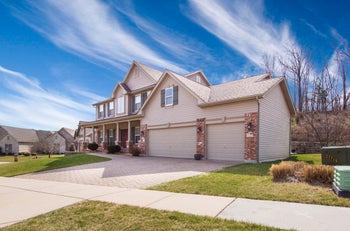4 Types of Foundation Repair Solutions
Table of Contents
1. What Is A Foundation?
2. Common Causes Of Foundation Problems
3. Common Signs Of Foundation Problems
4. Top 4 Foundation Repair Options
5. The Cost Of Common Foundation Repair Options
6. Will Insurance Cover Foundation Repair?
7. Buying Or Selling A House With Foundation Issues
8. How To Choose A Foundation Repair Company
Are you curious about your foundation repair options? If so, you’ve landed on the right page.
There are many types of solutions available for different foundations and problems.
In this article, we’ll explain the top four foundation repair options, the basics of foundations and how they work, common foundation problems, signs your home might have a foundation problem, what factors figure into the cost of repairing a foundation, and more.
What Is A Foundation?
A foundation is the lower supporting part of a structure. Its job is to take the structure’s load and transfer it to soil that can support it.
There are two general types of foundations: Deep foundations and shallow foundations. The terms ‘’deep’’ and ‘’shallow’’ refer to the soil depth where the foundation is constructed.
Engineers use shallow foundations when the soil near the surface can support the building’s structural load. With shallow foundations, the depth of the foundation is usually less than its width.
Deep foundations are used when the load needs to be carried past the less stable soil near the surface, and down to a depth where the soil is very strong. Skyscrapers, because of their heavy load, require deep foundations. The Shanghai Tower required drilling piles 282 feet into the ground. That’s equal to around 30 stories!
Common Causes Of Foundation Problems
The most common cause of foundation problems is something called differential settlement.
Here’s how it happens…
The majority of buildings experience a small amount of foundation settlement after they’re built. This is normal, and usually nothing to worry about so long as the settling is uniform. Uniform settlement means the entire building is settling into the soil at the same rate. The problems start when the structure settles into the soil unevenly. In other words, different parts of the structure are settling at different rates. This is called differential settlement.
Differential settlement can be caused by:
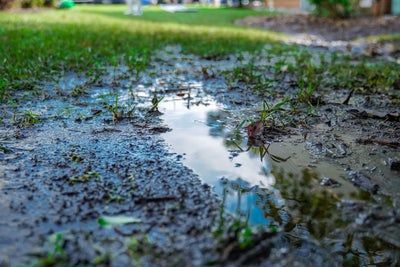
- Soil that hasn’t been properly prepared before construction. For example, soil that has been disturbed or soil that’s used for fill needs to be compacted before construction begins. Compaction increases the soil’s density and its ability to support a structure’s load. If this isn’t done correctly, there could be settlement later, and all the problems that accompany it. Almost all construction projects begin by mechanically compacting the soil.
- Expansive soil under the foundation. Expansive soils expand in volume as they soak up moisture, and shrink in volume as they dry out. This movement in the soil stresses the foundation because the swelling and shrinking of the soil never happens uniformly. The damage is caused by the fact that the foundation is not moving as one unit.
- Weather. If a foundation was built atop expansive soil during the summer when the soil was dry, it will experience movement during the wet season as the soil soaks up moisture and expands. When the dry season comes around again, the soil shrinks, causing movement once more. This back and forth, swelling and shrinking, puts a lot of stress on a foundation and can lead to differential settlement.
- Digging next to the foundation. If someone starts digging too close to your foundation, it can cause a loss of support. Picture digging a hole close to a chair on the beach. At some point, the chair will fall into the hole.
- Earthquakes. It goes without saying that seismic activity can cause serious problems for a foundation.
- Flooding. Water is a powerful force. Even slowly moving water can cause a building to separate from its foundation. It can also cause piers under the foundation to shift if they haven’t been drilled down deep into load-bearing soil.
If your home is experiencing differential settlement, it’s important to immediately contact an experienced foundation repair professional. They’ll do an inspection, and then discuss the various foundation repair options available to you.
Common Signs Of Foundation Problems
Signs of differential settlement include…
- Windows and doors that stick, or are hard to open
- Uneven, sloped floors
- Walls that have separated from the ceiling and/or the floor
- Cracks in walls, floors, and ceilings
- Bowed walls
- Diagonal cracks extending upward from the corners of doors and windows toward the ceiling. (If these are extremely thin, hairline cracks, there probably isn’t anything to worry about.)
- Torn wallpaper. This can happen if the wall behind the wallpaper moves.
- Drywall cracks or nail pops
- Rotated walls
- Moldings that have separated from walls or ceilings
- Stairstep cracks in brick or mortar
- Chimneys and porches that are separating from the rest of the building
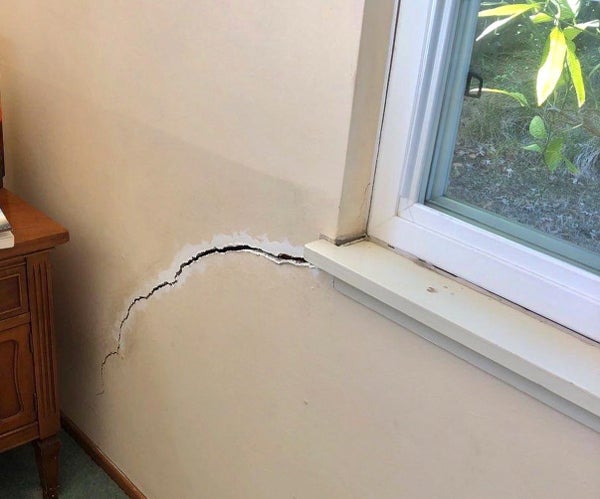
Top 4 Foundation Repair Options
Push Piers
Push piers, also called resistance piers, are driven down until they reach load-bearing soil using hydraulic pressure along with the weight of the building. Once they’re in place, hydraulic jacks are attached to them, and the building is lifted back up. For more information, see our Push Piers solution page.
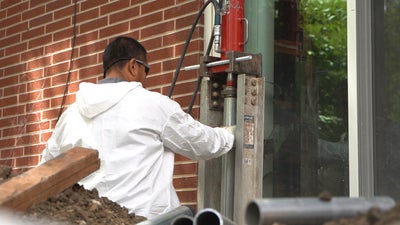
Helical Piers
Helical piers look like big screws. They’re screwed down until they reach load-bearing soil. The torque required to screw them down to the load-bearing soil determines their load-bearing capacity. Once they’re in place, hydraulic jacks are attached to them, and the building is lifted up.

Drilled Concrete Piers
Homes built on hillsides often develop foundation problems due to soil creep and lateral movement. Concrete piers can be used to resist this movement and re-stabilize the foundation. The procedure involves drilling large holes – about 18 inches in diameter and 15-30 feet deep – next to the foundation. After reinforcement cages are placed into the holes, concrete is poured in, creating a cast-in-place drilled concrete pier.

Screw Jacks
Sometimes a home will have signs of foundation settlement even though the foundation is perfectly sound. This usually happens when either the screw jacks in the crawl space have deteriorated, or the support posts have settled. These problems are easy to fix by installing heavy-duty crawl space support jacks. The floor can then be stabilized and potentially lifted back up.
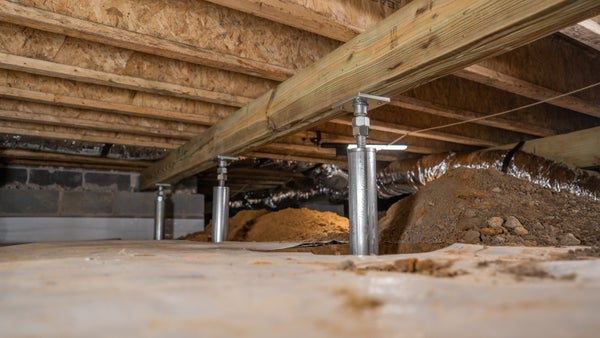
The Cost Of Common Foundation Repair Options
How much does foundation repair cost? Well, that depends. Unfortunately, it’s impossible for us to give you even a ballpark figure because the cost of the above foundation repair options depends on various factors. Each foundation problem and each situation is different. The cost of foundation repair depends on things like where you live, the type of damage, the extent of the damage, which of the foundation repair options is the best solution for you, and more.
To find the exact foundation repair cost for your particular situation, you’ll need to contact an experienced foundation repair contractor and ask for an inspection. After the inspection, they’ll be able to tell you exactly what’s wrong with your foundation, recommend a particular repair solution, and give you a repair estimate.
You can also contact a structural engineer and ask for an inspection. The engineer will write up a detailed report which will include the recommended solution. You can then take the report to the repair contractor. Some homeowners prefer to do it this way because they’re worried about repair contractors recommending expensive, but unnecessary, solutions.
All foundation repair work should come with a warranty, of course. However, remember that the warranty is only as good as the company offering it.
Will Insurance Cover Foundation Repair?
It might. It depends on what caused the foundation damage and what kind of coverage you have. Your foundation is probably covered by your homeowner’s insurance. However, certain types of foundation damage are almost certainly excluded unless you have riders for them. For example, earthquakes and floods. However, foundation settlement caused by age or poor construction is almost certainly not going to be covered, even with riders. The only way to know for sure is to check with your insurance company.
Buying Or Selling A House With Foundation Issues
Buying
Before you buy any house, you should have either a foundation repair contractor or a structural engineer, inspect it for foundation damage. If there is damage, find out how much it will cost to fix it so you can figure that into your offer.
Selling
A foundation problem does not make your home un-sellable. However, you will need to disclose the problem – in writing – to any potential buyers. So, the first thing you’ll need to do is contact either a foundation repair contractor or a structural engineer for an inspection. They’ll be able to give you a detailed report that you can then show potential buyers.
In a nutshell, you have two options. You can either fix the problem and then sell the house, or sell the house “as is’ to an investment buyer.
For more information about buying and selling a house with foundation problems, see How To Sell A House With Foundation Problems.
How To Choose A Foundation Repair Company
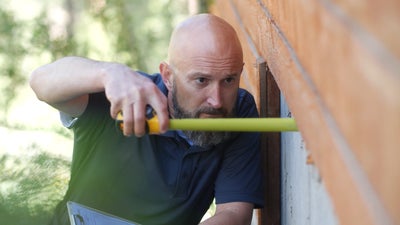
Above all, look for experience and check their references. Do you know anyone who has used the company to repair a foundation? What do they say? How did it turn out?
Of course, make sure the company is licensed and has liability insurance. Also, make sure they can clearly explain your specific foundation problem in terms that you understand. They should also be able to tell you why they’ve chosen a specific solution rather than something else. In other words, you should be able to understand exactly what’s going on. You shouldn’t be confused about your foundation problem or how they will fix it.
Ask them how long the repair will take. They should be able to easily give you this information.
Finally, read as much as you can about foundations, their problems, and how they’re repaired, and then ask the contractor many questions, including what kind of warranty they offer on their repairs.
The structural integrity of your home rests – literally – on the soundness of its foundation. If your home has a foundation problem, the good news is that most foundations can be repaired. Only in rare cases do foundations need to be totally replaced. If you’ve noticed signs indicating your home might have a foundation problem, contact an experienced foundation professional immediately for an inspection.
As a Northern California homeowner, we encourage you to contact our team at Bay Area Underpinning to schedule a free inspection. We’ll evaluate your home and provide you with a no-obligation repair estimate on customized solutions. Let us help you secure your home today!
More Resources
Publish Date:
Last Modified Date:

Our Locations
2333 Courage Dr. Suite C
Fairfield, CA 94533
1161 N Fair Oaks Ave
Sunnyvale, CA 94089

